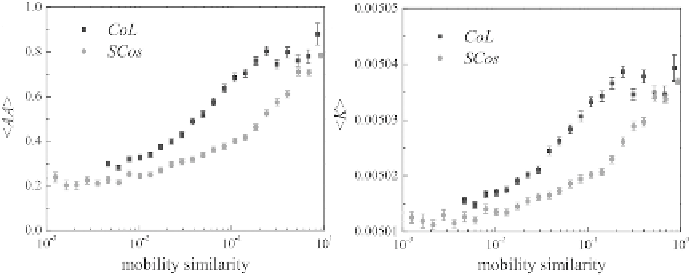Database Reference
In-Depth Information
Figure 15.7 Correlations between mobility measures and Adamic-Adar coefficient (left),
tie strength (right). The proximity measures used are the spatial co-location (
CoL
) and the
spatio-temporal co-location (
SCos
) inferred from the trajectories of the users. Figure from
Wang et al.
(
2011
).
carries high predictive power, comparable to that of network proximity mea-
sures. By combining both mobility and network measures, in the supervised
case authors obtained that only approximately one-fourth of the predicted new
links were false positives, and only one-third of the actual links were missed by
the predictor.
The results of the study by Wang et al. suggest that Granovetter's theory
should be integrated with a “mobility” dimension: as we can notice in Fig-
ure
15.7
, the strength of a tie is correlated not only to social proximity (the
extent to which people share the same community) but also to their mobility
behavior (the overlapping of their spatio-temporal trajectories).
Social Environment Affects Individual Mobility
Cho et al. investigated the interaction of a person's social network structure and
his or her mobility using data sets that capture human movements fromGowalla,
Brightkite, and phone location trace data. Because they uncovered a surprising
increase of the effect of distant friends on an individual's mobility, they tried to
understand if friendships influence where people travel, or if it is more traveling
that influences and shapes social networks. In order to measure the degree of
causality in each direction, they downloaded the Gowalla social network at two
different time points,
t
1
and
t
2
, three months apart. Considering friendships
at time
t
1
, they calculated a set of check-ins
C
a
that occurred after time
t
1
and quantified the influence of sociality on future movements by measuring
what fraction of them occurred within the vicinity of friends' homes. Similarly,
researchers examined the influence of mobility on creating new social ties by
examining a set of check-ins
C
b
before time
t
1
and counted the fractions of
check-ins that led to creation of new friendships. They found that whereas there
is, on average, a 61%probability that a user will visit a home of an existing friend,

